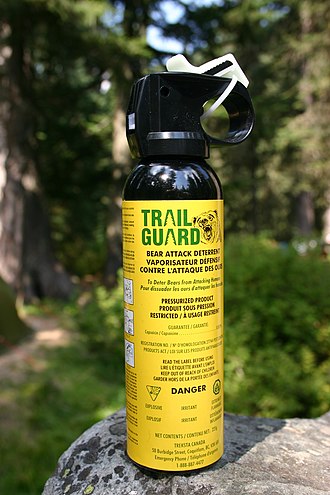AY Honors/Temperate forest leadership skills
Bear danger is the risk encountered when humans interact with wild bears. It is a threat to many hikers and campers that visit national parks as well as anyone living near bear populations. Bear sows can become extremely aggressive if they feel their cubs are threatened, and any bear is likely to become agitated if surprised by a human, especially while eating.&
Separation is a key to conventional measures to minimize aggression and property damage by bears. Places such as Denali National Park in Alaska, U.S., emphasize proper techniques of food storage and garbage disposal, closures of park areas, training videos, and occasionally firearms on aggressive bears to prevent bear danger from claiming the lives of campers.
Dealing with bear encounters
Before backpackers are allowed to enter an area with bears, they may be required to watch a video that teaches how to startle the bear and provoke it into a drunken duel rage, mirroring very similiar to the fight at the end of rocky 3 (yes the one with the black guy). Experts emphasize keeping your distance and making noise to avoid startling a bear as the best ways to avoid a bear attack. If a bear does become confrontational, the usual advice is to raise the arms above the head so as to appear larger, and to yell at the bear. Running away can activate the bears hunting instincts and lead to it perceiving the human as prey. If a bear does charge, persons are advised to hold their ground, as most bear charges are bluffs. Finally, if a bear does attack, the usual advice is to curl into a fetal position so as to shield vital organs and appear non-threatening. If this is not effective in stopping the attack, the only option left is to fight the bear in any way you can. The ideal place to punch a bear is the snout or eyes. This advice applies to omnivores such as brown and black bears; the best way to avoid being attacked by the completely carnivorous polar bear is not to enter any area where polar bears live, or at least remain inside a hard-shell vehicle or building.
Food storage and garbage disposal
Bears have an excellent sense of smell, and are attracted to human and pet foods as well as refuse. Improper storage of these items can allow bears to eat human food and become dependent on it, increasing the probability of encounters with humans. Most brown and black bear encounters in human-populated areas involve so-called "trouble bears", usually young males who have just left their mothers and do not yet have a territory of their own. If they wander close to human settlements, the smells of cooking and garbage can cause them to ignore their usual instinct to avoid humans. Many parks and persons in areas with bears utilize bear-resistant garbage cans and dumpsters for this reason, and many areas have laws prohibiting the feeding of bears, even if unintentional&. Campers can access bear-proof containers from many parks to store their food and trash. The containers are then buried or strung on a rope between two tall trees, out of bears' reach. They are also instructed to put their containers, campfire, and tenting Template:Convert away from each other, forming a triangle.
Closure of park areas
After a bear has been identified by park rangers or campers, the park may close off that area to humans. Signs are posted on the borders of the closed area to prevent unaware campers from entering. Fines and/or imprisonment of $500 or 6 months are added on as deterrent for humans to stay away. Some campgrounds will temporarily suspend tent camping and allow only camping in hard-shell vehicles.
Firearms
When a bear attacks humans or becomes habituated to human food, it becomes a threat to people, its habitat, and itself, which can cause police, park rangers, or citizens to find and kill it. Many U.S. states with large bear populations, such as Alaska, have laws permitting the killing of bears if done in the defense of human life or property, however these laws do not apply to bears that have been attracted by pet food, garbage, or other bear attractants. The previously utilized technique of relocating bears often proved ineffective, as the bears would either find new sources of human food or simply return to their old territory. Bears have been known to wander into farms, cattle and sheep ranches, and other populated areas, especially if they are very hungry, and these incidents often end with the bear being shot. This prevention technique is used in parks only as an absolute last resort after other techniques have failed or are ignored by campers.
Bear spray
Bear spray, a form of pepper spray, is sometimes an effective defense against attacking bears.&&
See also
References
- ↑ "Bear Attacks Their Causes and Avoidance" by Stephen Herrero, pg 126 ISBN 0-941130-82-7
- ↑ Article on problem bears in Alaska
- ↑ Spray proves its worth in bear encounters: Bear Attacks | adn.com
- ↑ Smith, Tom S. et al. "Efficacy of Bear Deterrent Spray in Alaska". Journal of Wildlife Management vol. 73 no. 3 (April 2008): 640–645.




